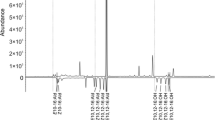Abstract
Studies to determine possible differences in the pheromone communication system of three different populations of the corn stalk borer Sesamia nonagrioides (Lef.) in France, Spain, and Greece were carried out. The two main pheromone components (Z)-11-hexadecenyl acetate (Z11–16:Ac) and (Z)-11-hexadecenol (Z11–16:OH), were detected in all analyses with very small differences in the three populations. Among the minor components, analyzed by GC-MS on concentrated gland extracts from French and Greek origin females, (Z)-11-hexadecenal (Z11–16:Ald) was detected in minor amounts. Wind-tunnel and field studies revealed similar a male response in the three populations to pheromone glands extracts and synthetic pheromone regardless of the female/male origin. The results do not support the assumption of the existence of different pheromone types of the corn stalk borer S. nonagrioides due to geographic isolation.
Similar content being viewed by others
REFERENCES
AmÉline, A.1999. Identification de la pheromone sexuelle de Sesamia nonagrioides(Lep., Noctuidae) et contribution a la comprehension des mechanismes de la confusion sexuelle. PhD dissertation. Université Paris-Nord, Paris.
Anglade, P.1972. Les Sesamia, pp. 1389–1401, inA. S. Balachowsky, (ed.). Entomologie Appliquée 00E0; I'Agriculture, Tome II. Lepidoptères, 2ème vol. Masson et Cie, Paris.
Babilis, N. A. and Mazomenos, B. E.1992. Mating behavior of the corn stalk borer Sesamia nonagrioides(Lef.) [Lepidoptera: Noctuidae]. Entomol. Exp. Appl. 65:199–204.
Barrer, P. M., Lacey, M. J., and Shani., A.1987. Variation in relative quantities of airborne sex pheromone components from individual female Ephestia cautella(Lepidoptera: Pyralidae) J. Chem Ecol. 13:639–653.
Bues, R., Eizaguirre, M., Toubon, E., and Albajes, R.1996. Comparaison enzimatique et écophysiologique des populations de Sesamia nonagrioides (Lepidoptera: Noctuidae) originaires de l'ouest du Bassin Méditerranéen. Can. Entomol. 128:849–858.
CardÉ, R. T. and Baker, T. C.1984. Sexual communication with pheromones, pp. 355–383, inW. J. Bell and R. T. Cardé (eds.). Chemical Ecology of Insects. Chapman and Hall, New York.
FrÉrot, B., Guillon, M., Bernard, P., Madrennes, L., Schepper, B., Mathieu, F., and Coeur, D.1997a. Mating disruption of corn stalk borer, Sesamia nonagrioides, Lef. (Lep., Noctuidae). Technology Transfer in Mating Disruption. IOBC WPRS Bull. 20:119–128.
FrÉrot, B., Malosse, C., and Cain, A. H.1997b. Solid-phase microextraction (SPME): A new tool in pheromone identification in Lepidoptera. J. High Resol. Chromatogr.20:340–342.
Haynes, K. F. and Baker, T. C.1988. Potential for evolution of resistance to pheromones:Worldwide and local variation in chemical communication system of pink bollworm moth, Pectinophora gossypiella. J. Chem. Ecol. 14:1547–1560.
LÖfstedt, C.1990. Population variation and genetic control of pheromone communication systems in moths. Entomol. Exp. Appl.54:199–218.
Mas, E., Lloria, J., Quero, C., Camps, F., and Fabri Às, G.2000. Control of the biosynthetic pathway of Sesamia nonagrioidessex pheromone by pheromone biosynthesis activating neuropeptide. Insect. Biochem. Mol. Biol. 30:455–459.
Mazomenos, B. E.1989. Sex pheromone components of the corn stalk borer Sesamia nonagrioidesLef.: Isolation, identification and field tests. J. Chem. Ecol. 15:1241–1247.
Perdiguer, A., Gimeno, F., Aguilar, R., Eizaguirre, M., Riba, M., and Sans, A.1992. Ensayos de confusiÓn sexual en Sesamia nonagrioides. Inv. Agric. Prod. Prot. Veg. 7:253–260.
Phelan, P. L.1993. Evolution of sex pheromone and role of asymmetric tracking, pp. 265–314, inB. D. Roitberg and M. B. Isman (eds.). Insect Chemical Ecology: An Evolutionary Approach. Chapman and Hall, New York.
Poitout, S. and Bues, R.1970. Elevage de plusieurs espèces de Lépidoptèptès Noctuidae sur milieu artificiel simplifié. Ann. Zool. Ecol. Anim.1:245–264.
Sans, A., Riba, M., Eizaguirre, M., and LÓpez, C.1997. Electroantennogram, wind tunnel and field response of male Mediterranean corn borer, Sesamia nonagrioides, to several blends of its sex pheromone components. Entomol. Exp. Appl. 82:121–127.
Sreng, I., Maume, B., and FrÉrot, B.1985. Analyse de la sécrétion phéromonale produite par les femelles vierges de Sesamia nonagrioides(Lef.) (Lépidoptére: Noctuidae). C. R. Acad. Sci. Ser. III301:439–442.
Tsitsipis, J. A., Mazomenos, B. E., Christoulas, C., Mouloudis, S., Stefanakis, M., Papageorgiou, G., Gliatis, A., and Sinis, G.1983. Report on the lepidopterous insects attacking corn in Greece with emphasis on the corn stalk borer, Sesamia nonagrioides. 9th Interbalkanic Plant Protection Conference, Athens, Greece.
Witzgall, P. and FrÉrot, B.1989. Pheromone emission by individual females of the carnation tortrix, Cacoecimorpha pronubana. J. Chem. Ecol. 15:707–717.
Author information
Authors and Affiliations
Corresponding author
Rights and permissions
About this article
Cite this article
Krokos, F.D., Ameline, A., Bau, J. et al. Comparative Studies of Female Sex Pheromone Components and Male Response of the Corn Stalk Borer Sesamia nonagrioides in Three Different Populations. J Chem Ecol 28, 1463–1472 (2002). https://doi.org/10.1023/A:1016256804745
Issue Date:
DOI: https://doi.org/10.1023/A:1016256804745




